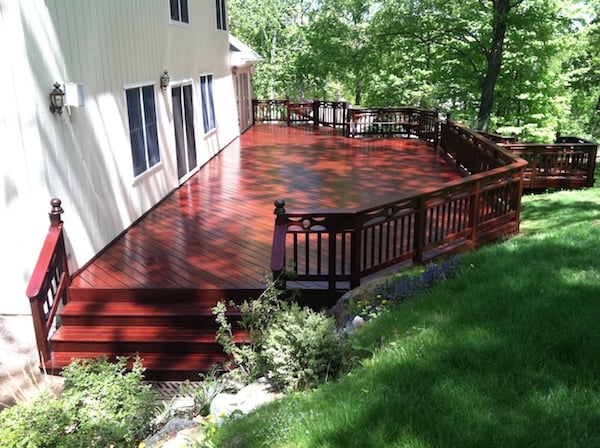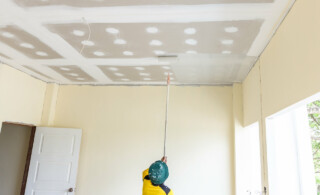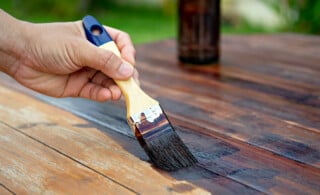On This Page:
- How to Effectively Seal & Stain Your Deck
- How Much Does it Cost to Hire a Pro?
- Deck Stain Prices
- FAQs
A beautiful, well-maintained deck not only provides extra space for relaxing and entertainment, but it also adds value to your home. Like any outdoor living space, however, the realities of Mother Nature make keeping up this type of space more challenging. Responsible ownership means taking special steps to protect your deck from wind, rain, sun and snow as well as the hands of time.
If you neglect it for too long, not only does the look and utility of the space diminish, but its materials begin to break down as well, leading to an unsafe surface full of protruding nails and wood ripe for splinters. The good news is that staining a deck to seal in its beauty and lengthen its life is a simple DIY task that requires more time than it does hard-earned skills.
How to Effectively Seal & Stain Your Deck
The main goal of a sealed and stained deck is keeping the wood fresh and strong by locking out moisture and preventing damage from the sun. Most commercial deck stains and sealants will do just that with only a coat or two, so long as the area is properly prepped and the stain is properly applied. Doing so requires first gathering the right materials and tools and then getting down to the business of staining.
Tools & Materials Needed
Below is a list of the items you need to purchase for a successful staining and sealing project along with the average price you can expect to pay for them.
- Stiff-bristle broom – $20
- Pump sprayer – $10–$20
- Deck cleaner – $10 per container
- Protective gloves – $10
- Safety mask – $10
- Garden hose with high-pressure nozzle – $40 + $15
- 80-grit sandpaper or sponge – $10
- Plastic sheet or drop cloth – $10-$25
- 2–2 1/2-inch paint brush – $10
- Paint roller and tray – $10
- Deck stain and/or sealant of choice – $25–$30 per gallon
Ready to start your deck staining?
Find ProsDIY: 8 Steps to Stain Your Deck
The process of actually staining a deck is pretty simple, but it’s notably divided into two distinct and equally important tasks: cleaning and preparation and the actual staining process. For the best and longest-lasting results, be sure to properly complete both of these tasks and allow the requisite time in between to give the seal and stain enough time to dry.
- Begin the cleaning process by removing all furniture and other objects from the deck surface and inspecting it for damage and protruding nails. Sand down any splintered boards with 80-grit sandpaper and an optional pole sander. Remove and replace any broken or rotted boards, and nail in any protruding nail heads to prevent snags. Once complete, sweep to remove large debris.
- Before actually applying the deck cleaner, be sure to wet and/or cover all live vegetation surrounding the space. Follow the manufacturer’s directions on the bucket or bottle of cleaning product regarding how to protect your plants. Then, apply the cleaner to a wet or dry surface (depending on the product) using the garden sprayer. Work the cleaner into the boards with the bristles of your broom and allow it to sit for the designated time (usually about 10 minutes) before rinsing away the cleaning solution with the garden hose fitted with a high-pressure nozzle.
- Once complete, allow the deck to dry for at least 48 hours, or the amount of time specified in the manufacturer’s directions, before moving on to the staining process. Because of this requirement, it’s a good idea to check the weather report before beginning a deck staining job to make sure you have adequate time without rain in between the cleaning and staining steps as well as immediately following the staining process.
- Prepare the sealer and/or stain according to the manufacturer’s directions, taking care to mix the entire batch thoroughly to ensure an even color across the surface of your deck. The following process works for applying both types of finishes.
- Begin by choosing a small section of 2–3 boards and carefully apply one thin coat over the section using a roller with an extension pole. Pay very close attention to the stain, avoiding any pools or puddles of stain or sealer and cleaning them up with a 2-inch paint brush. You may also choose to have a second person follow you around and smooth out those little pools with a paintbrush immediately after you apply the roller coat — a process called backrolling.
- Continue this careful process, focusing on a specific set of boards individually, across the entire deck. Be sure to use a paintbrush, rather than a large roller, to apply the stain or sealer in corners and on railings and poles.
- Allow adequate time for the stain or sealer to dry and then apply a second thin coat. Depending on the condition of the deck and the previous state of the sealant, you may only need to reapply a second coat in select areas, or not at all.
- Allow the deck to dry completely according to the time described on the package of your particular brand of stain or sealant. Once it is dry, re-rinse the surrounding vegetation and remove the plastic protective sheet, if you used one.
How Much Does It Cost to Hire a Pro?
While the process of staining a deck is simple enough as a DIY job, it does require one thing that’s at a premium for many homeowners: time. Because of the drying process, staining can take days to complete from start to finish, even if the actual active time involved is closer to 3–5 hours. In addition, the painting process is also quite tedious and may involve some uncomfortable bending, which may not be comfortable for older or mobility-impaired homeowners.
Furthermore, professional painters and contractors are much better suited to staining a deck that needs substantial repair, either to individual boards or structural components. They’re also more likely to get the painting done quickly and evenly.
If you need the help and experience of a pro, either because you’re short on time or aren’t comfortable handling the project yourself, the cost is about $2 per square foot of deck space, which works out to a range of about $500–$1,000 for most homes. Specific factors such as the cost of the stain may affect that total price. All told, according to our real cost reports, the average homeowner pays $840 to have a pro stain a deck.
When you’re calling pros to get a quote on a deck staining job, it’s important to ask them about their provisions for working around foul weather and what cleaning products they use, especially if you have vegetation nearby. Most pros will charge by the hour, though some may offer a price per square foot of deck — make sure to check and ask for a time estimate. A standard 500-square-foot deck, for example, should take no more than 3–5 hours total to clean and stain. Note, however, that additional projects such as repairing boards, stripping old paint or reinforcing structures will add to the time and material costs of any professional deck staining job.
Ready to start your deck staining?
Find ProsDeck Stain Prices
When you think about staining your deck, you might lump the different products used to create a waterproof barrier and even color into one, large pot. However, this is not only inaccurate, but it diminishes the great selection of products that are available for making your deck your own. It also discounts the different benefits and effects you can create when staining.
In general, there are four main categories of stain and sealant that you can choose, all offering different price ranges and attributes to the finished product:
- Transparent Stain: Transparent stain options work best with newer wood that has very little damage. Great for brand new decks or those that haven’t been exposed to much moisture, a transparent stain allows the grain of your wood to show through and gives off a natural, rustic look.
- Product Examples: WoodRx Ultra Natural, BEHR Wood Finish, Thompson’s Waterseal (Transparent)
- Average Price: $25–$30 per gallon
- Semi-transparent Stain: Very similar to transparent stain, semi-transparent stain also shows wood grain for a more natural effect. The difference is that semi-transparent stain contains some pigmentation, which allows you to match the tone of your deck stain to the color palette of your home or to hide slight blemishes and signs of age.
- Product Examples: Ready Seal, Thompson’s Water Seal (any tinted shade)
- Average Price: $35–$40 per gallon
- Solid-Color Sealant: When you’re working with older, distressed wood, solid-color sealant is a good option because it completely covers wood grain while still creating a vibrant, natural look. Available in different colors other than wood tones, solid-color sealant is a good way to add more character to your deck by including a contrasting or matching color around your home. Its properties as a sealant mean that this painting option will resist water just like typical stains.
- Product Examples: BEHR Premium Solid Color, Sure Step Concrete Coating, Sikkens ProLuxe
- Average Price: $30–$40 per gallon
- Restoration Paint: When you’re working with aging wood that’s just this side of replacement, a restoration paint is a good option. Providing not only weatherproof seals, but reinforcement and coverage for pitting and splintered wood, restoration paint is thicker than stain and sealant. For borderline cases, restoration paint can be a good alternative to completely replacing an old deck, adding years to an aging structure. Like solid-color sealant, restoration paint will not show the grain of your wood, but provide a solid, vibrant color on the surface, which is easy to match to the colors of your home.
- Product Examples: BEHR Premium DeckOver, Rust-Oleum Restore
- Average Price: $30–$40 per gallon
Deck Stain FAQ
What’s the difference between oil-based and water-based deck stains?
Technically speaking, the difference between oil-based and water-based stains is in their chemical composition and resulting cleanup. As their name indicates, oil-based stains require a mineral spirit or paint thinner to clean up, whereas water-based stains are those you can clean up with water alone. However, there’s also a difference in their application and results.
In general, oil-based stains are considered to be a better aesthetic option because they’re made of natural resins that penetrate deeper into the wood, bringing out its natural grain and leaving a richer, more natural finish. Unfortunately, despite the better looks of oil-based stains, they also have flaws including a chemical composition that makes it easy for mold and algae to penetrate. As a result, many wood-based stains contain a toxic chemical additive that prevents this growth, but this additive also washes away with time.
Water-based stains, though manmade, are therefore actually a “greener” option because they’re already naturally resistant to mold and algae growth and clean up without the use of toxic paint thinner. Their finish is not quite as deep or natural. However, some higher-end water-based stains do an excellent job of mimicking the deeper penetration of an oil-based stain.

 3 Benefits of Under-Deck Stain
3 Benefits of Under-Deck Stain  Decks and Porches Glossary
Decks and Porches Glossary  Best Type of Paint Rollers for Ceilings
Best Type of Paint Rollers for Ceilings  Best Type of Paint Roller for Walls, Cabinets, Ceiling & Floor
Best Type of Paint Roller for Walls, Cabinets, Ceiling & Floor  The Best Roller for Staining Wood Decks or Fences
The Best Roller for Staining Wood Decks or Fences 

Are You Familiar With This Topic? Share Your Experience.